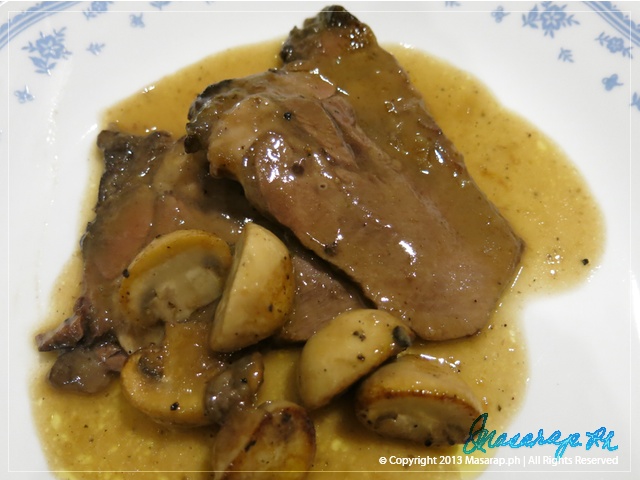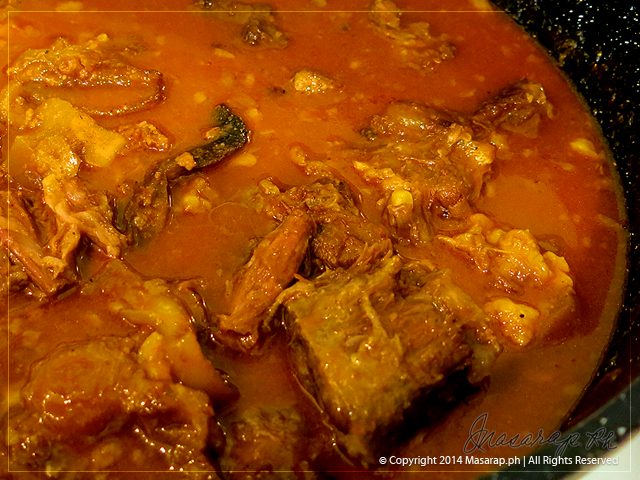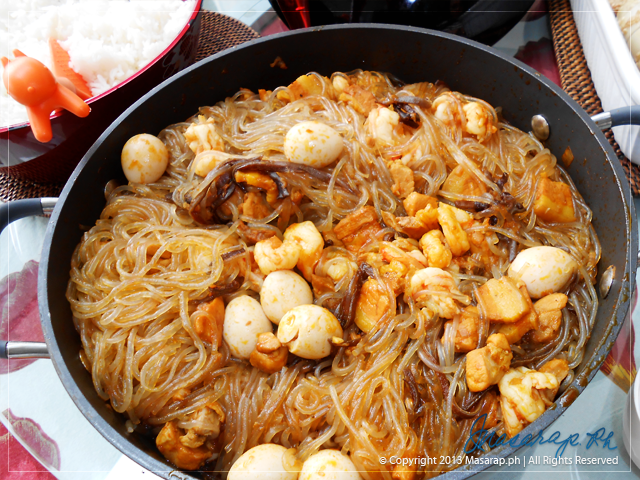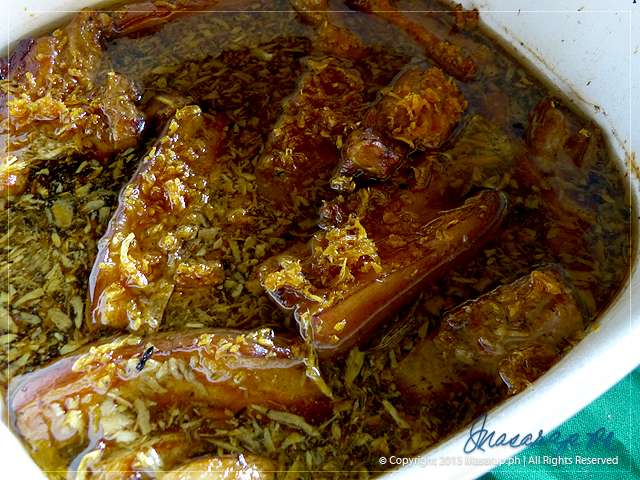Ox tongue is one of the cheapest cuts of meat nowadays because it takes a few hours to prepare and cook it; but one must remember there is hardly any part of the tongue that you discard. It has a different flavor from the other cuts of beef but with the addition of some herbs and spices, it has its own savory flavor. How to clean the ox tongue: In a pot that can totally submerge the ox tongue, fill with water and bring to a boil. Place the ox tongue in the water and let cook for half an hour. Remove the ox tongue from the liquid and remove the white membrane that surrounds the ox tongue. If membrane is hard to remove, return to the hot liquid and continue to boil for another 15 minutes. Keep doing this till all the white membrane is removed. In the USA, Australia and other countries, the ox tongue is already clean; this step is not necessary. Ingredients: 1 ox tongue (its around 1 plus kilo) water to cover tongue in a pot 2 bay leaves 10 whole peppercorns 4 pieces cloves 1 teaspoon salt 1 tablespoon tomato paste 2 onions – quartered ¼ cup soy sauce Garnishing: 100 grams mushrooms – cut into four (sauté mushrooms with 2 tablespoons of olive oil 1 carrot – cut into small squares and blanch in boiling water for 5 minutes ¼ cup green peas Sauce: 2 tablespoons flour 2 tablespoons butter 2 cups of cooking liquid 1 piece beef cube 1 tablespoon red wine salt and pepper to taste Tenderizing the ox tongue: In a pot, place ox tongue and add water till the tongue is fully submerged. Add the onions, bay leaves, peppercorns, cloves, salt, tomato paste and soy sauce. Bring to a boil and then simmer for 1 hour. Remove ox tongue from cooking and liquid and slice into desired size. I prefer to slice them into ¼-inch thick oblong pieces. Return the ox tongue into the cooking liquid and continue to simmer till the ox tongue is tender. Remove the ox tongue from the liquid and arrange in a baking dish. Make the sauce. Sauce: In a small sauce pan, over low fire, place the butter and flour. Using a wire whisk, stir the butter and flour till the smell of the flour doesn’t smell raw. Pour a fourth cup of cooking liquid into butter/flour mixture and stir well till well blended. Continue doing this until all the liquid (2 cups) have been added. Continue simmering for 5 minutes. Remove from fire and pour on top of ox tongue. Scatter mushrooms, carrots and peas on top of sauce. To make...
Meat / Karne
I could write a chapter of my life dedicated to my friendship with Antonio (Tony) Kornerup. Tony is now smiling down at me from that blissful place in Paradise and I miss his challenging company. Instead of writing that chapter for this particular recipe, I will instead write down what he wrote about me. This piece came about in 1996, when I had asked him to write something about me; something that I might use for the publication of my book “The Secret Is In The Sauce.†At that time of my life I didn’t want it too known that that I was a ‘witch’. But now, who cares if people know that I am a ‘witch’ and so, here is what Tony wrote about me. En el centro de la isla de Luzon, por alla en el ano de 1980. It was hot, hot, hot! The summer’s sun was at its peak, shinning over the plains of Central Luzon and over the Barangay San Isidro (not the one connected with the late famous fugitive), when a gentle breeze tickled my delicate and large nose with a subtle aroma that persisted over the dust and heat; it brought back from perennial memories the enchanting fumes given by cauldrons of magic concoctions performed by undefined and unknown culinary spirits. Enticed to follow it, I obeyed this strange compulsion until I discerned a very young and beautiful witch bent over cooking pans, emerging from cloudy steams, elaborating the family fare of the day, Kare Kare. Being a curious admirer of gourmet concoctions, I cast a spell inquiring about her enchantments. Her inner being was powered by a very strong will that flamed around her, like the interior fires that Mother Earth spews through active volcanic craters; her light was enticing yet dangerous; her warmth was sincere; her heart was very much palpitating with love for life, pain, concern, the Universe, the known and unknown, cooking and baking. That was my first look of MARIANNE As it was pre-ordained by destiny, we met physically in a very ordinary, every day store at the market place, in a dusty town with a Royal and Holy Name (San Fernando, Pampanga). Since then, through the years, glimpses of her life, her loves, her fights and difficulties, her quests in her way upon this Earth, were tenderly offered for sharing, commenting, dissecting, enduring and forecasting; knowing that the choices and decisions will dictate the outcome, the realization of dreams and enjoyment of daily toiling. Having a very active and restless mind, Marianne loves to experiment; to look for new ways to obtain and prepare new dishes; to share new culinary skills; should I mention her special...
To celebrate a Filipino birthday, it is a must to have noodles and the Filipino kitchen repertoire for noodles is a treasure trove. To inject being Asian, I have chosen to use the Korean glass noodle for this much loved noodle dish. Ingredients: 500 grams Korean glass noodles (vermicelli) – sweet potato noodles or sotanghon – soak in tap water for 30 minutes; cut into 12-inch lengths and drain 1/2 cup cooking oil 250 grams shrimps or very small prawns – peel; if shrimps, leave whole; prawns, peel, devein and cut into 1-inch slices or slice in half lengthwise 250 grams pork liempo – pork belly – slice 1/2-inch by 1/4-inch pieces 250 grams chicken thigh – slice 1/2-inch by 1/2-inch pieces 2 tablespoons minced garlic 1 cup chopped onion 3 tablespoons anato juice – soak 1 tablespoon anato seeds with 1 teaspoon lye water; mix well and then pour in 1/4 cup boiling hot water; leave to soak for ½ hour 10 grams dried wood ear mushroom (tenga ng daga) – soak in hot water and slice julienne 4 cups chicken broth – warmed 2 pieces chicken broth cubes or 2 tablespoons powdered chicken stock 2 tablespoons fish sauce (patis) 1 teaspoon fresh ground black pepper (to make it spicier – 1 teaspoon Jabanero sauce) 1 teaspoon salt Garnish 2 eggs and make an omelet – slice into thin strips or 1 doz. cooked quail eggs 1/4 cup spring onion – chopped Procedure: Use a medium sized wok; put over medium-low heat. Warm pot for 2 minutes. Pour oil into wok. Sauté garlic till light gold. Add in the onions and continue to sauté till the onions are translucent. Pour in the anato juice and turn flame to low. Continue sautéing till the anato juice does not smell metallic; around 10 minutes. Add the fish sauce and sauté for 1 minute. Turn flame to medium. Add the pork and chicken pieces and sauté for 5 minutes. Add in the shrimp and continue sautéing for 1 minute. Add the wood ear mushroom. Pour in chicken broth and chicken cubes and turn flame to medium-low and simmer for 15 minutes. Season with patis, pepper and salt. Simmer for another 5 minutes and adjust taste. Place the drained noodles in the mixed broth, cover and simmer till the noodles are done (around 10 to 15 minutes); but every once in a while, stir the mixture. Test noodles if done and then garnish with sliced egg and green onion. Serve with patis as dipping...
In whatever country you are in, everyone loves barbeque! And we Pinoys are no exception. But, we’re the only ones that have barbeques named ‘beta max’, ‘Addidas’, and ‘IUD’ to name a few. Here is a sure-fire marinade and procedure that will complete that gathering. The secret to barbeque tasting good to the bone, is marinating it for at the very least 12 hours prior to cooking; it lets the marinade seep in giving it that very savory taste. Ingredients: 1 kilo pork spare ribs – cut per rib strip or cut into 3-inch pieces or 1 kilo chicken legs and thighs or half and half 1/4 cup light soy sauce 1/2 cup white vinegar or ¼ cup calamansi or lemon or lime juice 1/4 cup (50 grams) brown sugar 2 – 4 pieces sili labuyo (bird’s eye chili) – chop finely 1 tablespoon finely crushed garlic 1/4 cup banana ketchup or tomato paste 1/2 cup lemonade (Sprite, 7-Up) 1/2 teaspoon MSG (optional) Procedure: Make a marinade of the soy, vinegar, sugar, chili, garlic, ketchup, lemonade and MSG. The best trick in marinating is to get a plastic bag (Zip-Lock or Glad) and fill it with the pork or chicken pieces. Pour in the marinade and seal bag; try to remove as much of the air. Place in the refrigerator for 24 to 48 hours. Every few hours, turn the bag around so that all the parts get the same flavor. Drain the sauce from the pork or chicken. Steam the pork pieces for 15 minutes. Steam the chicken parts for 20 minutes. Finish cooking by placing them over hot charcoal fire or oven grill till the meats are cooked; anywhere between 10 to 20...
Adobo was originally a Spanish dish, having been introduced four hundred years ago, but has become something Filipinos have since adopted and made their own. Indeed, there are as many versions of adobo as there are provinces in the Philippines. Practically each household has its own rendition of this traditional dish, each with its own distinct twist to the recipe. The basic ingredients are garlic and vinegar or another souring agent (tamarind, guava and even watermelon are not unheard of) and soy sauce. Some versions require coconut milk while others use olive oil. The viands required to fill the stew are also as varied. Aside from pork or chicken, one can make adobo with prawns, squid, lamb, goat, crabs, beef, vegetables (bamboo shoots, Chinese cabbage, potato, etc.) or even frog’s legs and balut (traditionally salted duck fetus). Once prepared, it is an invaluable companion to steaming hot rice and makes for a quick meal over the week, as the older it gets, the richer and more full-bodied its flavor. Even adobo’s leftovers need not go to waste. The sauce and oils can be used for frying leftover rice while the meat can be shredded and also fried to a crisp as Ropa Vieja.  Try this recipe if you want something distinctly home-cooked from the Archipelago. Ingredients: 1 kilo pork belly (liempo) and cut into 1-inch width by 2-inch lengths 1/2 cup soy sauce 1/2 cup vinegar 1 cup rum (Tanduay or Añejo, the white variant, you can also use your favorite rum brand) Soak the pork belly pieces in this mixture. 2 tablespoons crushed garlic 2 tablespoons cooking oil Sauté garlic in the cooking oil till light golden brown. Remove garlic from oil and drain on paper towel. 1 cup buco juice (young coconut juice, aka young coconut water) 2 tablespoons cooking oil 1 tablespoon crushed garlic 1 tablespoon freshly crushed black peppercorns 1 piece bay leaf (aka laurel) 1 sprig oregano or 1/2 teaspoon crushed oregano Salt to taste, start with 1/2 teaspoon. Procedure: Marinate the pork belly in the mixture of soy sauce, vinegar and rum for 2 hours. Drain from marinade and save marinade. In a non-corrosive cooking pot, such as glass, enamel, or non-stick, pour in the oil from the sautéed garlic plus 2 tablespoons cooking oil. Avoid using aluminum or stainless steel pans, they will add a metallic flavor to the meat. Place pot over medium-low fire and sauté the 1 tablespoon crushed garlic till very light gold. Put in the marinated pork pieces and sear. Turn the flame to low and pour in the pork marinade, buco juice, peppercorns, bay leaf, and oregano. Simmer the pork, stirring occasionally, till the pork is tender;...





Recent Comments